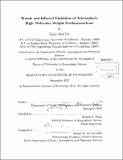Trends and inferred emissions of atmospheric high molecular weight perfluorocarbons
Author(s)
Ivy, Diane Jean
DownloadFull printable version (12.13Mb)
Other Contributors
Massachusetts Institute of Technology. Department of Earth, Atmospheric, and Planetary Sciences.
Advisor
Ronald G. Prinn.
Terms of use
Metadata
Show full item recordAbstract
Atmospheric observations and atmospheric observation-based global emission estimates are presented for the five high molecular weight perfluorocarbons (PFCs): decafluorobutane (C 4 F 1 0 ), dodecafluoropentane (C5 F1 2 ), tetradecafluorohexane (C 6 F14 ), hexadecafluoroheptane (C 7F 16 ) and octadecafluorooctane (C8 F 18 ). Their atmospheric histories are based on measurements of 36 Northern Hemisphere and 46 Southern Hemisphere archived air samples, collected between 1973 and 2011, using two of the "Medusa" cryogenic preconcentration gas chromatography-mass spectrometry instruments, which are part of the Advanced Global Atmospheric Gases Experiment (AGAGE). A new calibration scale was prepared for each PFC, with estimated accuracies of 6.8% for C4Fi0 , 7.8% for C5F12 , 4.0% for CF 14 , 6.6% for C7FE16 and 7.9% for CF8i . Based on our observations, the 2011 globally averaged dry air mole fractions of these high molecular weight PFCs are: 0.17 parts-per-trillion (ppt, i.e., parts per 1012) for C4 F 10 , 0.12 ppt for C5 F 1 2 , 0.27 ppt for CF 1 4 , 0.12 ppt for CFE16 and 0.09 ppt for CF 18 . Newly measured infrared absorption spectra are presented for C7F 16 and CF 1 8 , and using these, their radiative efficiencies and global warming potentials (GWPs) are estimated. We find that the radiative efficiency of C8 F 18 at 0.57Wm- 2 ppb-' is similar to that of trifluoromethyl sulfur pentafluoride's (SF 5 CF 3 ), which has the highest radiative efficiency of any known atmospheric species (Forster et al., 2007). Using their radiative efficiencies, the 2011 observed globally averaged atmospheric mole fractions of the above five high molecular weight PFCs combine to contribute a global average radiative forcing of 0.35 mW m-2, which is 6% of the total anthropogenic PFC radiative forcing (Montzka et al., 2011; Oram et al., 2012). Global emissions for C4 Fio, C5F 12 , C6 F 14 , C7 F 16 and CF 18 were estimated from the observations using a 3-dimensional chemical transport model and a Bayseian inverse method that included a constraint on the annual growth rate of their emissions, consistent with the knowledge of the relevant industries emitting them (Rigby et al., 2011). The derived so-called "top-down" emission estimates show that global emission rates were largest in the 1980s and 1990s for C4 F 10 and C5 F 12 and in the 1990s for C6F 14 , C7F16 and C8F1 . After a subsequent decline, emission rates have remained relatively stable, within ±20 % year-to-year variation, for the last 5 years. Using their calculated 100-year time horizon GWPs, the high molecular weight perfluorocarbons studied here contributed up to 15.4 % of the total PFC emissions expressed in carbon dioxide (C0 2)-equivalents in 1997 and 6 % of the total PFC emissions in 2009. Furthermore, we compare our atmospheric observation-based global emissions to the available so-called "bottom-up" inventories, which are based on production information and end usage. Bottom-up emission estimates are available from the Emission Database for Global Atmospheric Research version 4.2 (EDGARv4.2) for C4F1o, C5 F1 2, C6 F 1 4 and C7F16 , and emission inventories of C4Fio, C5 F1 2 and C6 F14 are also reported to the United Nations' Framework Convention on Climate Change (UNFCCC) by Annex 1 countries that have ratified the Kyoto Protocol (European Commission, Joint Research Centre (JRC)/Netherlands Environmental Assessment Agency (PBL), 2009; United National Framework Convention on Climate Change Secretariat, 2011). The atmospheric observation-based emission estimates are 20 times larger than EDGARv4.2 for C4F10 and over three orders of magnitude larger for C5F1 2 . In contrast, the top-down emission estimates for C6F14 largely agree with the bottom-up estimates from EDGARv4.2. Moreover, the top-down C7 F16 emission estimates are comparable to those of EDGARv4.2 at their peak in the 1990s, albeit with significant underestimation by EDGARv4.2 for the other time periods. There are no bottom-up emission estimates for C8Fi8 , thus the emission rates reported here are the first for this gas. In general, the emission inventories for C4Fio, C5F1 2 and C6F 14 reported to the UNFCCC are five to ten times lower than those estimated in this study from observations. This underreporting to the UNFCCC may be due to only Annex 1 countries reporting inventories and also that some of these countries report a total PFC mixture in C0 2-equivalents, instead of individual PFC emissions rates.
Description
Thesis (Ph. D.)--Massachusetts Institute of Technology, Dept. of Earth, Atmospheric, and Planetary Sciences, 2012. Cataloged from PDF version of thesis. Includes bibliographical references (p. 115-119).
Date issued
2012Department
Massachusetts Institute of Technology. Department of Earth, Atmospheric, and Planetary SciencesPublisher
Massachusetts Institute of Technology
Keywords
Earth, Atmospheric, and Planetary Sciences.